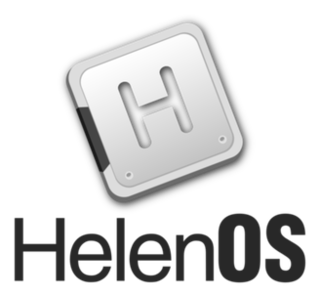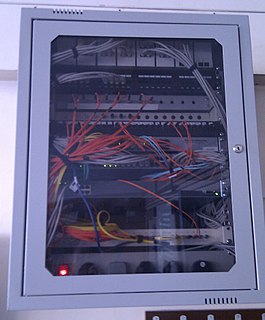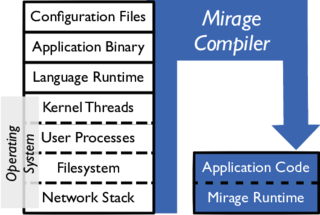
The graphical user interface is a form of user interface that allows users to interact with electronic devices through graphical icons and visual indicators such as secondary notation, instead of text-based user interfaces, typed command labels or text navigation. GUIs were introduced in reaction to the perceived steep learning curve of command-line interfaces (CLIs), which require commands to be typed on a computer keyboard.

In computer science, a microkernel is the near-minimum amount of software that can provide the mechanisms needed to implement an operating system (OS). These mechanisms include low-level address space management, thread management, and inter-process communication (IPC).

Plan 9 from Bell Labs is a distributed operating system, originating in the Computing Sciences Research Center (CSRC) at Bell Labs in the mid-1980s, and building on UNIX concepts first developed there in the late 1960s. The final official release was in early 2015.

Packet switching is a method of grouping data that is transmitted over a digital network into packets. Packets are made of a header and a payload. Data in the header are used by networking hardware to direct the packet to its destination where the payload is extracted and used by application software. Packet switching is the primary basis for data communications in computer networks worldwide.

A telecommunications network is a collection of terminal nodes in which links are connected so as to enable telecommunication between the terminals. The transmission links connect the nodes together. The nodes use circuit switching, message switching or packet switching to pass the signal through the correct links and nodes to reach the correct destination terminal.

An embedded system is a controller programmed and controlled by a real-time operating system (RTOS) with a dedicated function within a larger mechanical or electrical system, often with real-time computing constraints. It is embedded as part of a complete device often including hardware and mechanical parts. Embedded systems control many devices in common use today. Ninety-eight percent of all microprocessors manufactured are used in embedded systems.

QNX is a commercial Unix-like real-time operating system, aimed primarily at the embedded systems market. The product was originally developed in the early 1980s by Canadian company Quantum Software Systems, later renamed QNX Software Systems and ultimately acquired by BlackBerry in 2010. QNX was one of the first commercially successful microkernel operating systems and is used in a variety of devices including cars and mobile phones.
The end-to-end principle is a design framework in computer networking. In networks designed according to this principle, application-specific features reside in the communicating end nodes of the network, rather than in intermediary nodes, such as gateways and routers, that exist to establish the network.

PROFIBUS is a standard for fieldbus communication in automation technology and was first promoted in 1989 by BMBF and then used by Siemens. It should not be confused with the PROFINET standard for Industrial Ethernet.
PROFIBUS is openly published as part of IEC 61158.
Computer science and engineering (CSE) is an academic program at some universities that integrates the fields of computer engineering and computer science. It is a sub-field of electronics engineering, covering only the digital aspects of electronics engineering, specializing in hardware-systems areas like computer architecture, processor design, high-performance computing, parallel processing, computer networks and embedded systems. CSE programs also include core subjects of computer science such as operating systems, theory of computation, design and analysis of algorithms, data structures and database systems. The program aims at designing, developing and troubleshooting computing devices, focusing the underlying fundamental issues in the most efficient and effective way.
K42 is a discontinued open-source research operating system for cache-coherent 64-bit multiprocessor systems. It was developed primarily at IBM Thomas J. Watson Research Center in collaboration with University of Toronto and University of New Mexico. The main focus of this OS is to address performance and scalability issues of system software on large-scale, shared memory, NUMA multiprocessor computers.

A computer network is a digital telecommunications network which allows nodes to share resources. In computer networks, computing devices exchange data with each other using connections between nodes. These data links are established over cable media such as wires or optic cables, or wireless media such as Wi-Fi.

HelenOS is an operating system based on a multiserver microkernel design. The source code of HelenOS is written in C and published under a BSD License.

Fiber-optic communication is a method of transmitting information from one place to another by sending pulses of light through an optical fiber. The light forms an electromagnetic carrier wave that is modulated to carry information. Fiber is preferred over electrical cabling when high bandwidth, long distance, or immunity to electromagnetic interference are required.

The Centre for Development of Advanced Computing, formerly, Thiruvananthapuram, is a Scientific Society of the Department of Information Technology, Ministry of Communications & Information Technology, Government of India. It is a National Centre of Excellence, pioneering application oriented research, design and development in Electronics and Information Technology.

The kernel is a computer program that is the core of a computer's operating system, with complete control over everything in the system. On most systems, it is one of the first programs loaded on start-up. It handles the rest of start-up as well as input/output requests from software, translating them into data-processing instructions for the central processing unit. It handles memory and peripherals like keyboards, monitors, printers, and speakers.

Feature phone is a term typically used as a retronym to describe a class of devices that are still technically otherwise smartphones, besides their lack of highly advanced hardware and capabilities of modern ones. Feature phones tend to use a proprietary, custom-designed software and user interface, and typically provide voice calling and text messaging functionality in addition to basic multimedia and Internet capabilities and other services offered by the user's wireless service provider. Feature phones have a backlit LCD screen and micro USB port and have a physical keyboard, a microphone, SD card slot, a rear-facing camera to record video and capture pictures; and GPS. Some feature phones include a rudimentary app store that include basic software such as mobile games, calendar and calculator programs.
A lightweight kernel (LWK) operating system is one used in a large computer with many processor cores, termed a parallel computer.
A distributed operating system is a software over a collection of independent, networked, communicating, and physically separate computational nodes.
They handle jobs which are serviced by multiple CPUs.
Each individual node holds a specific software subset of the global aggregate operating system. Each subset is a composite of two distinct service provisioners. The first is a ubiquitous minimal kernel, or microkernel, that directly controls that node’s hardware. Second is a higher-level collection of system management components that coordinate the node's individual and collaborative activities. These components abstract microkernel functions and support user applications.

A unikernel is a specialised, single address space machine image constructed by using library operating systems. A developer selects, from a modular stack, the minimal set of libraries which correspond to the OS constructs required for their application to run. These libraries are then compiled with the application and configuration code to build sealed, fixed-purpose images (unikernels) which run directly on a hypervisor or hardware without an intervening OS such as Linux or Windows.















